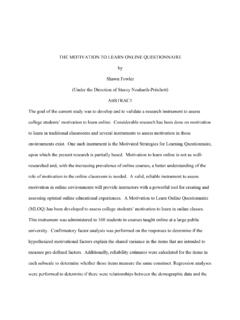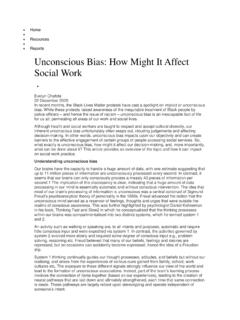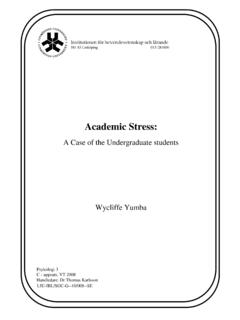Transcription of MATHEMATICS SELF-EFFICACY AND ANXIETY QUESTIONNAIRE
1 MATHEMATICS SELF-EFFICACY AND ANXIETY QUESTIONNAIRE by DIANA K. MAY (Under the Direction of Shawn Glynn and Denise S. Mewborn) ABSTRACT College MATHEMATICS achievement is often influenced by students MATHEMATICS SELF-EFFICACY and MATHEMATICS ANXIETY . Consequently, instructors strive to build students MATHEMATICS SELF-EFFICACY or alleviate MATHEMATICS ANXIETY , but instructors lack the tools to reliably, validly, and efficiently assess these constructs. A major goal of this study was to develop a reliable, valid, and efficient QUESTIONNAIRE to assess college students MATHEMATICS SELF-EFFICACY and MATHEMATICS ANXIETY . This QUESTIONNAIRE , called the MATHEMATICS SELF-EFFICACY and ANXIETY QUESTIONNAIRE (MSEAQ), was designed to assess each construct as a subscale of the QUESTIONNAIRE . Relationships among students QUESTIONNAIRE responses and individual characteristics such as gender, high school MATHEMATICS preparation, and grades in college MATHEMATICS courses were examined.
2 Interviews also were conducted with a random sample of the students to determine that the QUESTIONNAIRE was effective in assessing these constructs and to provide more insight into the quantitative findings. The QUESTIONNAIRE was found to be reliable, relatively valid, and efficient to administer. Correlations between items on the QUESTIONNAIRE and items on two other, established questionnaires, provided evidence of construct validity. Furthermore, an exploratory factor analysis of the students QUESTIONNAIRE responses identified five clusters of items (factors) that indicated how the students conceptualized the items: general MATHEMATICS SELF-EFFICACY , grade ANXIETY , MATHEMATICS SELF-EFFICACY on assignments, MATHEMATICS for students futures, and SELF-EFFICACY and ANXIETY in class. On the general MATHEMATICS SELF-EFFICACY factor, students who had passed their most recent precalculus exam were found to have higher MATHEMATICS SELF-EFFICACY and lower ANXIETY than students who had failed their most recent precalculus exam, providing additional evidence of construct validity.
3 There were no differences found in MSEAQ scores due to gender or high school MATHEMATICS preparation. The MATHEMATICS SELF-EFFICACY and ANXIETY QUESTIONNAIRE that resulted from this study merits improvement and continued research. It will benefit researchers who wish to explore relationships among college students MATHEMATICS SELF-EFFICACY , MATHEMATICS ANXIETY , other student characteristics, and criterion variables such as MATHEMATICS achievement. The QUESTIONNAIRE will also benefit instructors who wish to better understand their students MATHEMATICS SELF-EFFICACY and ANXIETY in order to increase their students achievement. INDEX WORDS: MATHEMATICS SELF-EFFICACY , MATHEMATICS ANXIETY , College MATHEMATICS , Motivation, Grade ANXIETY MATHEMATICS SELF-EFFICACY AND ANXIETY QUESTIONNAIRE by DIANA K. MAY , University of Michigan, 2004 , Oakland University, 2006 A Dissertation Submitted to the Graduate Faculty of The University of Georgia in Partial Fulfillment of the Requirements for the Degree DOCTOR OF PHILOSOPHY ATHENS, GEORGIA 2009 2009 Diana K.
4 May All Rights Reserved MATHEMATICS SELF-EFFICACY AND ANXIETY QUESTIONNAIRE by DIANA K. MAY Major Professors: Shawn Glynn Denise S. Mewborn Committee: Dorothy Y. White Jeremy Kilpatrick Electronic Version Approved: Maureen Grasso Dean of the Graduate School The University of Georgia August 2009 iv DEDICATION I would like to dedicate this dissertation to my husband, Brian. Thank you so much for your unending love and support. v ACKNOWLEDGEMENTS As I have worked on my PhD for the past few years, there are several people who have influenced and helped me along the way.
5 First, I would like to thank my committee members, Dr. Dorothy White and Dr. Jeremy Kilpatrick. Their advice was an invaluable contribution to my dissertation. Also, I would like to thank Dr. Denise Mewborn, my co-major professor, for her constructive feedback throughout my entire degree program. I would especially like to thank Dr. Shawn Glynn, my other co-major professor. I am extremely grateful for his guidance and advice, which helped calm me down and make it through the rough patches of my degree program. I would like to thank my entire family, who have supported me throughout all of my educational pursuits. To my mother and step-father, Gail McCarver and Ron Hines, thank you so much for all of your help and encouragement, which gave me the confidence to continue my education. To my sister, Melissa Kamel, whom I have looked up to all of my life, I appreciate your love and support, which have kept me going all of these years. To my father, Ron May, I am extremely grateful for your ability to help calm me down and your willingness to talk to me every day, regardless of what was going on.
6 Finally, I would like to thank my husband, Brian Swanagan. I definitely do not deserve your love and I only hope that I can support you as much as you have supported me. vi TABLE OF CONTENTS Page ACKNOWLEDGEMENTS ..v LIST OF TABLES .. viii LIST OF FIGURES .. ix CHAPTER 1 INTRODUCTION ..1 2 LITERATURE REVIEW AND THEORETICAL FRAMEWORK ..4 MATHEMATICS SELF-EFFICACY ..4 MATHEMATICS ANXIETY ..9 Theoretical Framework ..15 General Expectancy-Value Model ..17 3 METHODOLOGY ..21 QUESTIONNAIRE Development ..21 Participants and the Precalculus Assessment Procedures ..23 Interviews ..24 4 RESULTS ..26 Scale Verification ..26 Exploratory Factor Interviews ..37 vii Students Background Variables.
7 45 5 DISCUSSION ..49 Conclusions ..52 Implications ..54 Future Research ..56 Summary ..58 REFERENCES ..60 APPENDICES ..68 A Pilot Version of the MSEAQ ..68 B MATHEMATICS SELF-EFFICACY and ANXIETY QUESTIONNAIRE ..70 C Item Correlations Between MSEAQ and Previous Scales ..72 D Pattern and Structure Matrices for viii LIST OF TABLES Page Table 1: Mean, Standard Deviation, Score Range, and Cronbach s Alpha for Five Scales ..27 Table 2: Correlations among Five Scales ..28 Table 3: Mean and Standard Deviation for MSEAQ Items ..30 Table 4: Communalities for Table 5: Parallel Analysis Results ..33 Table 6: Pattern Matrix for General MATHEMATICS SELF-EFFICACY Table 7: Pattern Matrix for Grade ANXIETY Table 8: Pattern Matrix for Future Table 9: Pattern Matrix for In-Class Factor and Assignment Table 10: Results of t test for Gender.
8 46 Table 11: Results of t test for High School Courses ..47 Table 12: Results of t test for Precalculus Table 13: Correlations between MSEAQ SELF-EFFICACY Items and MSES Tasks Subscale ..72 Table 14: Correlations between MSEAQ ANXIETY Items and s-MARS Table 15: Pattern Matrix for EFA ..80 Table 16: Structure Matrix for ix LIST OF FIGURES Page Figure 1: Scree plot for 1 Chapter 1 INTRODUCTION Background and Rationale As college MATHEMATICS instructors respond to the need for fostering students MATHEMATICS literacy, the important role of students MATHEMATICS SELF-EFFICACY has received increased attention (Hannula, 2006; Pape & Smith, 2002).
9 MATHEMATICS SELF-EFFICACY is commonly defined as individuals beliefs or perceptions regarding their abilities in MATHEMATICS . Bandura (1997) suggested that students with higher levels of SELF-EFFICACY tend to be more motivated to learn and more likely to persist when presented with challenging tasks. Bandura identified four main sources of SELF-EFFICACY : mastery experiences, vicarious experiences, social persuasion, and physiological states. Students base most of their beliefs about their abilities on their mastery experiences. For example, students who have repeatedly succeeded in previous MATHEMATICS courses will most likely believe that they have the ability to succeed in future MATHEMATICS courses. Vicarious experiences involve students observing social models similar to themselves succeeding with particular tasks. Although this does not contribute as strongly to SELF-EFFICACY as mastery experiences, students will feel more confident in MATHEMATICS if they see students they perceive as similar to themselves succeeding in MATHEMATICS .
10 The final two sources contribute the least to students SELF-EFFICACY . Social persuasion refers to encouragement, both positive and negative , from peers, teachers, and parents. Physiological states refer to the student s physical state such as fatigue, pain, or nausea. Poor MATHEMATICS SELF-EFFICACY in college students often decreases their motivation to learn and eventually can lead to low MATHEMATICS achievement. In a study of college freshmen enrolled in a developmental MATHEMATICS course, Higbee and Thomas (1999) found that 2 MATHEMATICS SELF-EFFICACY , along with other affective factors such as test ANXIETY and perceived usefulness of MATHEMATICS , influenced students mathematical performances. The results of their study suggest to instructors that focusing on teaching mathematical content is insufficient for some students to learn MATHEMATICS .







